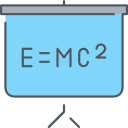
Skripsi
UJI IN SILICO EKSTRAK ETANOL KULIT BUAH DELIMA MERAH (Punica granatum L.) YANG BERKAITAN DENGAN HIPERPIGMENTASI SERTA UJI ANTIOKSIDAN
Penilaian
0,0
dari 5Skin hyperpigmentation occurs due to excessive melanin production, causing certain areas to be darker than the surrounding skin. The use of anti-hyperpigmentation agents such as kojic acid and hydroquinone that work by inhibiting the tyrosinase enzyme can cause to serious side effects. Therefore, safer natural alternatives are needed. This study analyzes the potential of ethanol extract of red pomegranate peel (Punica granatum L.) in related to hyperpigmentation through the In Silico tests with network pharmacology and molecular docking approaches, as well as antioxidant test using the DPPH method. The results of network pharmacology analysis obtained six main proteins in regulation related to hyperpigmentation, namely EGFR, AKT1, FGF2, STAT3, SRC, and TP53. Potential compounds, namely kaempferol, ellagic acid, gallic acid, and oleamide could potentially interact with these proteins. The main signaling pathways, which are involved include PI3K-akt signaling pathway, the MAPK signaling pathway, and the FoxO signaling pathway. The molecular docking results showed that ellagic acid has the highest affinity to AKT1 (binding affinity -10.55 kcal/mol), which is characterized by the presence of hydrogen and hydrophobic bonds on the active side of the protein. The antioxidant activity of the extract showed an IC50 value of 109.503 ppm, classified as a moderate antioxidant category. These results confirm the potential of ethanol extract of red pomegranate peel as a natural antihyperpigmentation agent.
Availability
| Inventory Code | Barcode | Call Number | Location | Status |
|---|---|---|---|---|
| 2507001670 | T169222 | T1692222025 | Central Library (Reference) | Available but not for loan - Not for Loan |
Detail Information
- Series Title
-
-
- Call Number
-
T1692222025
- Publisher
- Indralaya : Prodi Ilmu Farmasi, Fakultas Matematika dan Ilmu Pengetahuan Alam Universitas Sriwijaya., 2025
- Collation
-
xviii, 158 hlm.; ilus.; tab.; 29 cm.
- Language
-
Indonesia
- ISBN/ISSN
-
-
- Classification
-
582.120 7
- Content Type
-
Text
- Media Type
-
-
- Carrier Type
-
-
- Edition
-
-
- Subject(s)
- Specific Detail Info
-
-
- Statement of Responsibility
-
MI
Other version/related
No other version available
File Attachment
Comments
You must be logged in to post a comment
 Computer Science, Information & General Works
Computer Science, Information & General Works  Philosophy & Psychology
Philosophy & Psychology  Religion
Religion  Social Sciences
Social Sciences  Language
Language  Pure Science
Pure Science  Applied Sciences
Applied Sciences  Art & Recreation
Art & Recreation  Literature
Literature  History & Geography
History & Geography